Freidrich von Schlegel (1772-1829), the German writer, critic, philosopher, philologist and author wrote: “ Great India is not only at the origin of everything, she is superior in everything, intellectually, religiously or politically and even the Greek heritage seems pale in comparison. Here is the actual source of all languages, all the thoughts and poems of the human spirit; everything, everything without exception comes from India.”
- Buddha & Buddhism
- Gandhi
- Indian Mathematicians
- Festivals of India
- Indian Mathematics: A European Perspective and Redress
- Places to Visit
- Aryabhata
- Nalanda
- Ajanta & Ellora caves
- Indian classical dance
- Taj Mahal
- Kalarippayatt
- Temple Complexes of Tamil Nadu
- Indian Classical Instruments
- Musical Wonders of India - Victoria and Albert Museum
- Tagore
- Khajuraho
- Raja Yoga Meditation
- Ashoka the Great
- Art Forms of Kerala
- "If there is a country on earth which can justly claim the honor of having been the cradle of the human race….that country assuredly is India”, so wrote the German Philologist and archaeologist Friedrich Creuzer (1771-1858)
- The World's Oldest Civilization: Off the Coast of North Western India - Ancient City Called Dwarka - 9,500 Years Ago Video Series
Editor's Note: The video presentation above entitled "First Civilization" is courtesy of YouTube videos and the contents are entirely researched, produced and presented by the authors. We do not have independent research findings to support or refute the claims made in this video. However, we have strong opinions about the European (mainly British) narrative that there was an "Aryan invasion" of India around 1500 BCE, and they were responsible for bringing their languages and culture to the country. Included in those "gifts" from these conquering heroes from somewhere in Europe, included the Vedas and Upanishads, the earliest theological teachings of Hinduism. Of course, the intent of this story is not to give indigenous Indians credit for any cultural activities. Well, the Vedas were written at least as early as 3000 BCE, because all the Vedas mention a large river called "Saraswati" that was flowing and nourishing the Indus Valley inhabitants. This river started to dry up around 3000 to 2000 BCE and completely dried around 1900 BCE, a few hundred years before the imaginary cultured folks appeared in this area. If the river Saraswati dried up much earlier as asserted in this video, the Vedas were of course written that much earlier, and that much more ancient than the "Aryan invaders' " misadventures.
- Debunking the Myth of the Aryan Invasion Video Series
- The Untold Story of Sanskrit - A film on research about Sanskrit & Computing
- The history of Hindu numerals: when, where, who and how, they were invented
The video segment below presenting the national GDP PPP from 1AD to 2020 AD was courtesy of a YouTube post. The author(s) admit that they had to use current or previously known name of a nation (or nations) just as an identification tool. Good examples are "Soviet Union" (such an entity did not exist in the early centuries, of course), and Indonesia, or even the United Kingdom. We should assume that the major country in the respective locality was what they meant to identify. For example, Russia in the case of Soviet Union, England in the case of United Kingdom and whatever other names the nation state(s) that is currently represented by Indonesia. Another striking situation is that of USA; clearly, this country only came into existence in the eighteenth century. Readers, please accept such understandable inconsistencies in the presentation. The editors of indiancentury.com do not have first-hand knowledge of the source or sources of the data presented in this video and as such do not vouch for the validity of them.
The video presentation below is another post on YouTube in 2024, and the contents were the result of the presenter(s) own research and assessment. Once again, the editors of this website are not responsible for the contents of the video segment, however, the recent developments adequately support their evaluation. Examples abound in the innovative always in which India has used cutting edge technologies in many areas. Indian Space Program accomplishing a mission to land on Mars on their very first attempt, the only country that has accomplished that feat, and to land on the South Pole of Moon on their second attempt, two excellent examples. In accomplishing both of these feats, India's ISRO (India's Space Agency) proved that they are ahead of all other space programs in some segments of space technology. Also, some other accomplishments include rendering warplanes and drones invisible to enemy radar and infra-red detectors, simply by applying appropriate coatings, instead of expensive architectural modifications to the vehicles, and, by applying AI technology in offensive maneuvers, changing direction and target instantly when the target moves, another game changer! In civilian life, Indian Government's application of AI in all digital payments, in bringing education to remote regions and in aiding farmers with solving their problems and many other new applications, India is moving ahead fast. Increasing numbers of private startups have introduced us to innovations such as 3D printed cheap rocket, powered by electric motor driven semi -cryogenic rocket engine, yet another first in the world. Mahindra, an indigenous car manufacturer showed their prowess in using AI at every step of the manufacturing process. One interesting use of AI technology they used was in adjusting the suspension system in nanoseconds to make for smooth driving in even rough terrain. We look forward to many more innovations from India in the coming decades.
INTRODUCTION

Mark Twain
“This is India; Cradle of human race, birthplace of human speech, mother of history, grandmother of legend, great grandmother of tradition, whose yesterdays bear date with the smoldering antiquities of the rest of the nations…India had the start of the whole world in the beginning of things. She had the first civilization, she had the first accumulation of material wealth, she has the populous with deep thinkers and the subtle intellects; she had mines and woods and fruitful soil”.
Indeed, Mark Twain was right on target. In every field of human endeavor, Indians had made their mark. In its long and illustrious existence as a civilization, which, probably extends at least to 7 to 9 thousand BCE (the now-submerged city of Dwarka, which is located near the coast of Gujarat in Northwest India bears witness to this), it even made the first city-dwelling civilization, about 3 Millennia before the Sumerians. The video segments posted below explain further the archeological findings in Dwarka. Please click on the link below to visit a video on Dwarka:
http://www.indiancentury.com/dwar.htm
Before embarking on the project of constructing this website, we wondered about how many contemporary scholars are aware of the above facts that were unearthed by the genius of Mark Twain. It is our impression that both non-Indians and a large number of Indians lack adequate understanding about India and the enormous contributions ancient Indians had made to world culture. We believe the failure of the Indians stems from the carefully crafted curricula that the British imposed on the Indian educational system. They carefully erased the contributions ancient India and Indians made to all branches of science, to literature, and to theology and philosophy. Thus, generations of Indians grew up not even knowing the names of the geniuses who made India from antiquity a magnet for scholars from around the world. Second was the miserable failure of the Indian Government and its Tourism Board in projecting an appropriate image of India, in its advertising series, “Incredible India”. We will elaborate on the latter theme below, at the appropriate section in this “Introduction”.
Our research into the contributions made by ancient Indians in many diverse fields of human endeavor made deep impression on us. We were particularly impressed by their dominance in the fields of theology and philosophy, in mathematics and astronomy, in classical music and dance, their pioneering work in the fields of surgery and medicine and even in fields we had never suspected, such as the martial arts (“Kalarippayatt”). Equally compelling was the fact that India had not been accorded proper acknowledgement by the world community for all these enormous contributions, which is, in the breadth and depth truly unmatched by any other ancient culture. Adding to our distress was the recognition that most of these accomplishments of ancient Indians have been given to other cultures, notably the Arabs (mathematics), Greeks (democracy, philosophy, astronomy) and the other Europeans (mathematics and especially astronomy). Some examples of such intellectual credit transfers are exposed in the two presentations given below; please click on the links below
1) VIDEO: The history of Hindu numerals: when, where, who and how, they were invented This video presents a detailed description of how, why and when all branches of mathematics were invented by Indians.
2) The second presentation is from the School of mathematics and Statistics at the University of St. Andrews, Scotland; please click on the link below to access this incomparable compilation of Indians' contributions in the field of mathematics, and how, systematically the Europeans erased India's achievements and transferred credits for those to the Arabs, Greeks and other Europeans: https://mathshistory.st-andrews.ac.uk/Projects/Pearce/chapter-1/
Below, we present some glaring examples of such intellectual transfers that have not, until recently, been recognized by much of the world scholars:
- The Arabs who learned from the Indians the notations for the numeral system (numbers from 1-9) and then, with the transmission of these to the Europeans, they (the Arabs) were given credit for them. Thus the notion of “Arab Numerals” appeared. With the recognition of the truth, the scientific community changed that name to “Indo-Arab Numerals” (rather than, simply “Indian Numerals”).
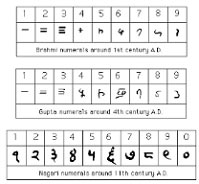
The above figure shows the evolution of the Indian Numeral System - While the Indians invented the notation for zero (0), the unique “Hindu” numeral system and the “Decimal Place value system”, without which useful mathematics could not have been done, there are lecture series offered by Professors in American Universities, that do not even mention these three seminal inventions, thus depriving India and Indians the proper credit. I have watched at least two segments dealing with mathematics on the PBS ( the Public broadcasting TV series on science and technology, called “Nova”, broadcast weekly in the US), both of which gave most of the credit for mathematics to the Greeks and other Europeans, without mentioning India’s contributions, even edgewise! One would be hard pressed to find a single seminal discovery that Greeks have made in mathematics.

-
Aryabhata (476 CE), who described succinctly the decimal place value system; however, this system had been in use in India many centuries before that. He was the first to suggest that the day starts at midnight and not when the Sun rises and he gave us the first astronomical constant, that between the moon and the sun. He also recognized that the orbits of the planets were elliptical ( a Millennium before Johannes Kepler) and that the solar and lunar eclipses occur because of the shadows of moon and the earth ( and not due to the demon "Rahu" swallowing the sun and moon). There are many more original observations and discoveries by this astounding genius of old India. Please check our more detailed description of his contributions to mathematics and astronomy in the "Culture" segment of this website.
- The Greek mathematician Pythagoras was a student of the Indian mathematician Baudhayana and learned the so-called “Pythagorean Theorem” while there. When he returned home and transmitted that to the locals, no mention of the great Indian Mathematician was made. This still remains unchanged.

Baudhayana, (800 BCE) an Indian Mathematician, who originally
described the so-called “Pythagorean Theorem” - BRAHMAGUPTA (598 CE): Brahmagupta is another notable genius who contributed immensely to mathematics by laying down some fundamental principles in all segments. Notable are his use of zero as a true number and laid down the fundamentals of using it in arithmetics, his formula for cyclic quadrilaterals in geometry, and his Interpolation formula in Trigonometry.
- There are numerous infinite series that bear the names of Europeans (such as Leibnitz series, Gregory series, Fibonacci series etc.) but all of which were described by Indian mathematicians many centuries earlier. Now, with the recognition of this fact by the scientific community, a partial redemption has been made by adding the original Indians’ names to the existing name(s). Again, it would have been more appropriate to remove the Europeans’ names and simply put those in parenthesis as “the earlier or old” name.
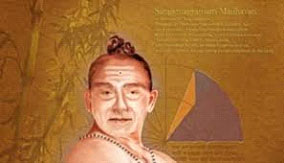
-
Madhava of Sangamagrama (1340 to 1425 CE), who described many of the infinite series,
which were originally credited to European mathematicians. Further, both he and the brilliant students of his “Madhava school of mathematics and astronomy” invented calculus, at least 200 years before Newton and Leibnitz. - The so-called “Caesarean section” was invented by the great Indian surgeon, Sushruta, hundreds of years before the birth of Caesar. This procedure should rightly be called “Sushruta’s section”. He also pioneered plastic surgery, cataract extraction and many other surgical procedures.
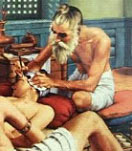
-
SUSHRUTA (900 BCE), OPERATING ON A PATIENT’S FACE
Another Indian contribution to world civilization was democracy and self-government. At least two centuries before Greece and Rome experimented with this system of government, a small town called Vaishali in Bihar state in Northeast India invented this system. This followed the abdication of their king and, his subjects elected officials from among themselves to rule themselves. Of course, the Greeks were given credit for this as well, adding to the contributions this “crucible of human civilization” had made.
- In astronomy, the Indian notions of gravitation, the elliptical orbits of the planets in the solar system and the axial rotation of the earth giving rise to the illusion of the “heavens” rotating around the earth were all ideas that, a Millennia later, credits for which were given to Europeans ( (Newton, Kepler and Copernicus, respectively) the details of these are in the appropriate section in this series).
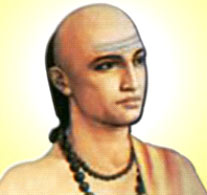
Varahmihira (475 CE), who recognized the existence
of gravity, more than a Millennium before Newton. - Then there are popular misconceptions about the origin of certain items that began in India and spread to the rest of Asia and elsewhere. Prominent among these are Buddhism (most Westerners believe the Buddha was a Chinese) and the martial arts (“Kalarippayatt”, the ancient martial arts form from South India), that was transmitted to the Chinese by a Buddhist monk called “Bodhidharma”. The Chinese, Japanese and Koreans became associated with developing the systems but few consider India as the original source of the system.

Kalarippayatt practitioners in sword fight
It will be interesting to speculate that the origin of Yoga and Meditation will be the next idea of Indian origin that credit could easily be transferred to (perhaps) Americans, centuries from now. That is, if such things as TV programs, DVDs and other recording means had not been available to us. We feel confident that these two will remain known as Indian contributions to humanity! The impact that India had made on the rest of Asia, especially through Buddhism, is evident when one notes a Korean Buddhist monk in orange robe, wearing a dot on the forehead, bowing and greeting in the Indian style “Namaste”, and giving and receiving objects with the right hand, supported by the left hand (which is a gesture of respect, just as the Namaste is ( by the way, this quintessential Indian way of mutual greeting means “I bow to the divine in you”). We will be discussing the Indian system of martial arts called Kalarippayatt later in this Introduction. Already the condiments and spices that enriched the Indian cuisine, such as coriander, turmeric, cumin, ginger, cloves, cinnamon, cardamom, nutmeg and many less used items are commonplace in cuisines all over the world. The recognition of the Indian origin of the culinary techniques incorporating such ingredients is already fading; such are the cuisines of the Caribbean and African cultures, and Southeast Asia and the Middle East. Such use is now rampant in Western cuisines as well; how the Indian condiments enriched the world culinary culture will be easily forgotten. Lest, series such as ours remind the visitors of them.
Even more interesting are actual food items of Indian origin that were co-opted by other cultures and given new names. Some examples of these are, Samoosa (an Indian spicy “appetizer”) became “Sambusa” in Ethiopian cuisine; the Indian Protta became “Roti Chanai” in Malaysia and Singapore; the South Indian Masala Vada (a snack) transformed into the Middle Eastern “falafel“; the Indian classic Biriyani turned into “Yellow rice” in Malaysia, and as their favorite item for wedding receptions. There are numerous such examples; in fact, wherever Indians had traveled, their cuisine influenced the local palate, sometimes to such a degree, it is now impossible to even recognize the origin of the dishes. There are many examples of these in the Caribbean and Malaysian cuisines. There are also whole regional cuisines that are based on the Indian system. For example the various “curries” that the Thai cuisine is famous for. The latest innovation in the Western (especially the American) cuisine is the addition of curry powder or Garam masala , both of which are mixtures of Indian spices. When cardamom or cinnamon is added to the western style desserts, the credit should also go to India. The most extreme example is of Nations adopting Indian dishes as their National dish; one such example is Singapore adopting 'Fish Head Curry' as theirs and the other, Britain adopting 'Chicken Tikka Masala' as theirs. Just imagine the case of India adopting Sushi or Steak as its National dish!
Our second motivation stemmed from the fact that the Indian government had done such a dismal job of popularizing India’s natural gifts and achievements. When one sees the (usually) silly advertisements Indian government’s tourism board puts out in the West, Indians could easily cringe. These advertisements are, presumably, made with the purpose of informing the would-be traveler to India and make them really want to undertake the journey!

SOME ARCHITECTURAL WONDERS
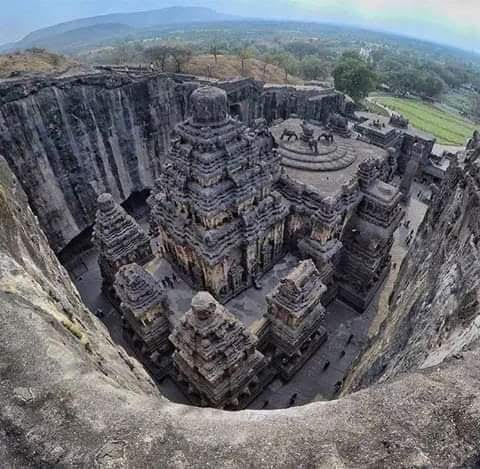
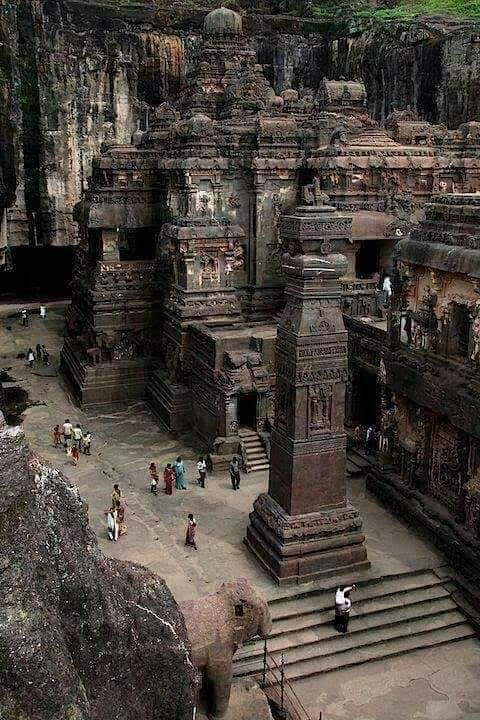
THE ABOVE TWO IMAGES ARE OF KAILASHNATH TEMPLE IN MAHARASHTRA STATE. THIS TEMPLE WAS CUT OUT OF A SOLID GRANITE BOULDER THE SIZE OF A SMALL HILL, AND WAS SCULPTED FROM ABOVE DOWN IN A MULTIGENERATIONAL EFFORT OVER ALMOST 200 YEARS! THIS, MORE THAN ANY OTHER STRUCTURE, (INCLUDING THE TAJ) QUALIFIES TO BE A WONDER OF THE WORLD, OF ANY LIST, SHORT OR LONG !
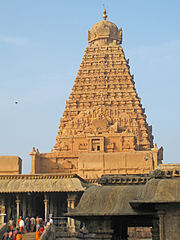
BRIHADISVARA TEMPLE ("PERIYAKOIL)
TANJAVOOR, TAMIL NADU
THE BRIHADISVARA TEMPLE SHOWN ABOVE, IS ANOTHER MAJOR HINDU TEMPLE. THE ARTICLE IN WIKIPEDIA ON THE TEMPLE, WHICH IS PRESENTED BELOW HAS BEEN POSTED WITHOUT ANY MODIFICATIONS; WE ARE DEEPLY INDEBTED TO WIKIPEDIA FOR THE FACT-FILLED ARTICLE. PLEASE COPY AND PASTE THE URL IN YOUR SEARCH BAR. THE LINK BELOW WILL TAKE YOU TO A SHORT VIDEO SHOWING THE AERIAL VIEW OF THE TEMPLE.
http://indiancentury.com/cms-content/VIDEO-2022-01-12-04-23-56.mp4
https://en.wikipedia.org/wiki/Brihadisvara_Temple
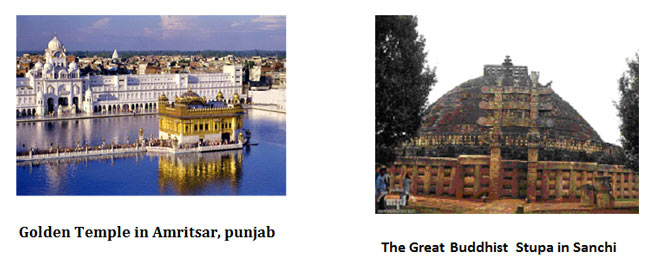
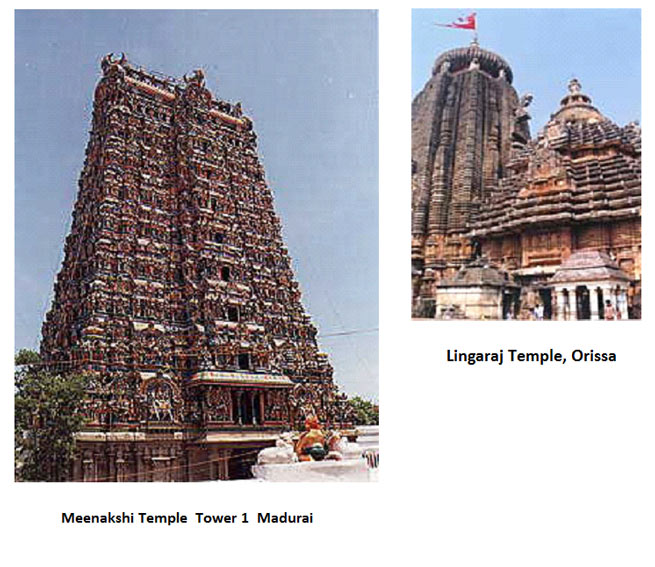
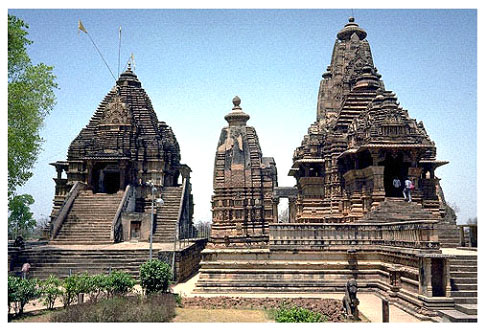

The exquisite temple carvings of Khajuraho
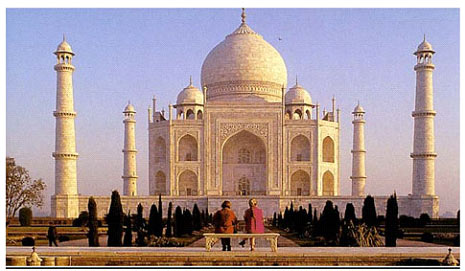
TAJ MAHAL, AGRA
TWO SPLENDID MEMBERS OF THE INDIAN FAUNA

It is difficult to see how a Westerner would want to travel to India, just because the advertisements show a middle-aged man with a prominent moustache or aboriginal women trekking the land. It is incomprehensible that such advertisements have never focused on topics such as the Buddha, Gandhi, the Indian geniuses who gave us mathematics, the variety of architectural gems peppered all over India (not just the Taj Mahal), such as the exquisite temple carvings of Khajuraho, the Kailashnath temple, the numerous temples and temple complexes of South and North India, the Ajanta and Ellora cave sculptures etc., the rich variety of fauna and flora that are indigenous to India, the major Indian cities, the vast coastal areas and the beaches, all of which are just the tip of the iceberg. Pilgrims from East and Southeast Asian countries would flock to the sacred sites of Buddhism, if adequate advertising is done regarding the Buddha’s history and teachings. Pilgrims of another sort, from perhaps the colder countries of Europe could easily be drawn to the lush landscape of Kerala and Goa and, especially in the former, the air-conditioned “House boats”. Some segments in this series provide even more pictures of such locations. Finally, Indian classical dance routines are unmatched in both their exquisite movements and gestures, as well as the way that they usually narrate stories in Hindu mythology. The most admired of all the Indian dances are Bharata Natyam, from Tamil Nadu and Katha Kali from Kerala, images of both of which are posted below. In fact each region in India boasts of their unique dance system, as is described in the Culture section in this website.
INDIA BOASTS VARIED CLIMES AND FLORA, FROM TEMPERATE KASHMIR AND THE STATES BORDERING THE HIMALAYAS, TO BALMY TROPICS, AS WELL AS DESERTS AND MANGROVES

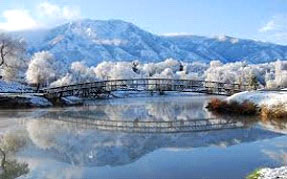
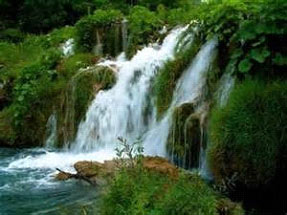
SHOWN ABOVE ARE TWO SCENES FROM HIMACHAL PRADESH
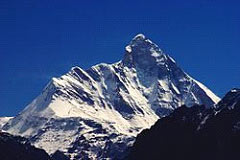
AN UTTARAKHAND MOUNTAIN SCENE
TWO EXAMPLES OF DANCE FORMS OF INDIA
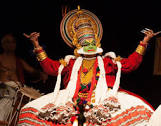

We hope this website will help dispel the ignorance of many of the readers about the wide variety of landscape India has. For example, India has, on its northern border temperate places with scenery that can match anywhere in Switzerland. India also has mangroves in its Northeastern state of Bengal and dry, desert-like places on its Northwestern parts such as Rajasthan. Unfortunately, this parched-land scenery is what comes to most people’s minds when they think about India. Once again, this is a failure of the government of India.
MODERN SKYLINES OF MAJOR CITIES IN INDIA
MUMBAI

Mumbia Skyline at Night
Some Mubai Skyscrapers

























KOLKATA




BENGALURU











HYDERABAD



PUNE AND AHMEDABAD CITY IMAGES
PUNE











AHMEDABAD










ACCOLADES FROM WORLD SCHOLARS
India’s contributions to world culture were colorfully described by Mark Twain as follows:

“This is India; Cradle of human race, birthplace of human speech, mother of history, grandmother of legend, great grandmother of tradition, whose yesterdays bear date with the smoldering antiquities of the rest of the nations…India had the start of the whole world in the beginning of things. She had the first civilization, she had the first accumulation of material wealth, she has the populous with deep thinkers and the subtle intellects; she had mines and woods and fruitful soil”.
Below, we will post quotations from some other eminent scholars about the significance of the Indian civilization:

Will Durant, the Pulitzer Prize winning American author wrote in The Case for India: "India was the mother of our race and Sanskrit the mother of Europe's languages. She was the mother of our philosophy, mother through the Arabs, of much of our mathematics, mother through the Buddha, of the ideals embodied in Christianity, mother through village communities of self-government and democracy. Mother India is in many ways the mother of us all"
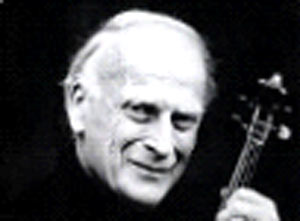
“ India is the primal source, the mother country”: Sir. Yehudi Menuhin (1915-1999).
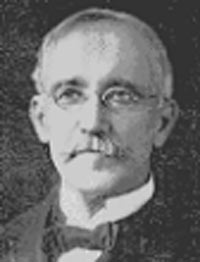
“ India early created the beginning of nearly all of the sciences, some of which she carried forward to remarkable degrees of development, thus leading the world”. So wrote Rev. Jabez T. Sunderland (1842-1936). He continued: “India was a far greater industrial and manufacturing nation than any in Europe or than any other in Asia….She had great engineering works. She had great merchants, great businessmen, great bankers and financiers.”
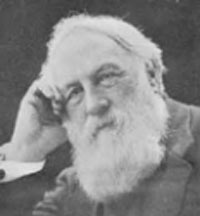
H.M. Hyndman (1842-1921) an eminent British publicist wrote: “ Many hundreds of years before the coming of the English, the nations of India had been a collection of wealthy and highly civilized people, possessed of great language with an elaborate code of laws and social regulations, with exquisite artistic taste in architecture and decoration, producing conceptions which have greatly influenced the development of the most progressive races of the West.”

Beatrice Pitney Lamb, former editor of he United Nations News wrote in her book: India: A world in transition: “ In addition to the still visible past glories of art and architecture, the wonderful ancient literature…. For well over a millennium and a half, the Indian subcontinent may have been the richest area in the world.”

General Joseph Davey, (1812-1851), the author of “A History of the Sikhs” wrote: “ Mathematical science was so perfect and astronomical observations so complete that the paths of the sun and the moon were accurately measured.”

William Cooke Taylor (1800- 1849), the author of “A Popular History of British India” Wrote: “ It was an astounding discovery that Hindustan possessed, in spite of the changes of the realms and changes of time, a language of unrivalled richness and variety; a language, the parent of all those dialects that Europe has fondly called classical- the source alike of Greek flexibility and Roman strength.”

Count Louis Hamon Cheiro (1866-1936) wrote: “ Long before Rome or Greece or Israel was even heard of, the mountains of India point back to an age, of learning, beyond, and still beyond. From the astronomical calculations that the figures in their temples represent, it has been estimated that the Hindu understood the precession of the equinoxes centuries before the Christian era.”
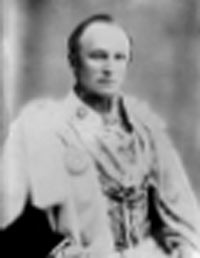
Lord Curzon (1859-1925) viceroy of India from 1899-1905 and Chancellor of Oxford University wrote: “ Powerful empires existed and flourished here (in India) while Englishmen were still wandering, painted in the woods and while the English colonies were a wilderness and a jungle.”

The German philologist and archaeologist, Friedrich Creuzer (1771-1858) wrote in “The Mother of Us All”: “If there is country on earth which can justly claim the honor of having been the cradle of the human race or at least the scene of primitive civilization, the successive developments of which carried into all parts of the ancient world….that country assuredly is India.”

Ali bin Abi Talib, the Fourth Caliph (656-661) wrote in Hindu Muslim Cultural Accord, “The land where books were first written and from where wisdom and knowledge sprang is India.”
Freidrich von Schlegel (1772-1829), the German writer, critic, philosopher, philologist and author wrote: “ Great India is not only at the origin of everything, she is superior in everything, intellectually, religiously or politically and even the Greek heritage seems pale in comparison. Here is the actual source of all languages, all the thoughts and poems of the human spirit; everything, everything without exception comes from India.”
So, how did India end up as a symbol of poverty and backwardness in the world? This had taunted me for a long time. What happened to Bihar, which was from time immemorial the seat of culture and government in India (Magadha in Hindu mythology) is illustrative of what happens to a nation that has material wealth and goods coveted by foreigners. Bihar state in modern India is poor and near the bottom of the pile among the Indian states, in both literacy rate and Human Development Index (HDI). This transformation was the direct result of centuries of invasions of India by, especially the Muslims and destruction of the monuments, temples and other structures of value, until Magadha’s soul was destroyed.
Even before the time of Alexander the Great, India was a magnet to foreign invaders, as well as traders and scholars. Even Christopher Columbus who set sail and charted a course to the West, and had no knowledge of a landmass in his way, was going in pursuit of the “Indies”. Wave after wave of Islamic and Central Asian invasions had already begun to suck the lifeblood of India in the latter part of the first Millennium CE. . But the process was completed by the European colonizers, who unlike the Muslims, did not make India their home but looted the wealth of India and gave precious little in return. While Europe reaped the benefits of this transfer of wealth, which fueled the Industrial revolution and scientific developments, the Indians were not given the benefit of such improvements in industries, improvement in education or proper control of population growth. Is there any wonder then, by the time the British finally left India, the country was one of the poorest in the world, and having almost insurmountable problems in every aspect of life? For most of the past two Millennia (until the eighteenth and nineteenth centuries) both India and China were the most affluent in the world; they would go through cycles of dominance, with the combined GDP exceeding 40% of world GDP. India under Mughal rule (right before the European colonization) was the richest country in the world, having 25% of the world GDP. The newly free India had to literally build industrial, educational, healthcare, family planning and all other aspects of the society, literally from scratch. After seventy years of independence, India is now poised to regain its prior eminence and its rightful place in the world. My hope is that in the not-too-distant future, "the Celestial Abode of Learning", that the Chinese Emperors used to call India, and "the Heaven on earth" that the Japanese used to describe India would once again become a reality!
ADDENDUM: (MARCH 2023)
It is with considerable satisfaction that we post this editorial comment. Since the Modi government came to power in 2014, the policies adopted by the administration have begun to transform India in ways previously unimagined, but, as outlined above, fulfilling the promise independent India had always held. Corruption is at record low levels and revenue at record high levels, both of which mean the government has funds to unleash that potential. That translates to infrastructure construction at record levels, with modern highways crisscrossing the country. Modernization of the airports and railways and public transportation is taking place at giddying pace. Similarly, modernization of the army, measures to control cross-border terrorism and swift action to curb internal terror plots have brought stabilization of previously unmanageable security situation. The cities and townships all across the country are renewing, with similar growth and transformation of previously sleepy states, such as Uttar Pradesh, which is, arguably perched at the top of the list now. To sum, from our wantage point, the current leadership is poised to transform India into the position India held for almost throughout its history, at or near the top among nations, both in material wealth and in knowledge-based enterprise. We expect the funds flowing into the modern industries such as IT, renewable energy, AI etc. will, in short order take India to her destiny. That brings us to the rationale behind calling this website “Indiancentury.com”. Back in 2005 when we started work on it, it was a distant vision but, we can clearly predict now India is well on its way to the top of the pile. What about China, you ask? Well, for the past two Millennia, China or India had been number one and two in the world, and history is simply repeating itself!
Jai Hind!!
BELOW WE POST SOME VIDEOS AND PICTURES THAT ATTEST TO THE ACCOMPLISHMENTS OF PRIME MINISTER MODI, AS WELL AS THE SUCCESS OF INDIANS IN VARIOUS FIELDS BOTH IN INDIA AND ABROAD. THEY CLEARLY SHOW WHERE BHARATH AND HER CHILDREN ARE HEADED!
Why Indian Immigrants Become Rich and Raise Successful Kids
Video 1: The above video is a presentation by an Armenian/Iranian; he is showing an analysis of U.S. Government's most recent Census report on the various ethnic groups and their stats.
Video 2: The video above shows a short glimpse of the notable achievements of the current Modi Government in infrastructure developments and in other areas.
Video 3: This video is a presentation by an American scholar on the potential of the modern India and Indians.
Video 4: In this video a U.S. congressman is describing Indian immigrants as model citizens of America.
Video 5: Above is a short presentation about the Modi Miracle, with facts to support the presenter's assertions.
The short video above shows the top five cuisines and the special features of their respective country's culinary offerings.
The picture below shows immigrants from India, who are currently CEOs (in 2024) of major American/International companies, most are in the IT section.

